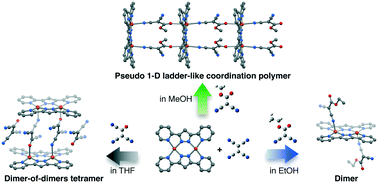Versatile coordination architectures of products generated by the in situ reaction of a doubly bis(2-pyridyl)pyrazolate bridged dinuclear copper(ii) complex with tetracyanoethylene†
Abstract
The reaction of a doubly bis(2-pyridyl)pyrazolate (bpypz−) bridged dinuclear copper(II) complex, [Cu2(bpypz)2]2+, with neutral tetracyanoethylene (TCNE) results in the formation of [Cu4(bpypz)4(TCVA)2]·2TCVA (1) in tetrahydrofuran (THF), syn-[Cu2(bpypz)2(DCNM)2] (2) in MeOH, and anti-[Cu2(bpypz)2(DCNE)2] (3) in EtOH, where TCVA− = 1,2,2-tricyanoethenolate, DCNM− = 2,2-dicyano-1-methoxyethenolate, and DCNE− = 2,2-dicyano-1-ethoxyethenolate. The ligands TCVA−, DCME−, and DCNE− in 1–3 were formed in situ during the reaction in different solvents, and the ligands were confirmed through infrared spectroscopy, single-crystal X-ray diffraction, and elemental analyses. The single-crystal X-ray structures of 1–3 show that each copper(II) centre is five-coordinate in an approximately square pyramidal geometry. 1 is a discrete dimer-of-dimers type tetranuclear complex with the copper(II) centres bridged by two trans-μ2-N,O-TCVA−. 2 and 3 are discrete dinuclear complexes. In 2, two apically monodentate N-coordinated DCNM− molecules are oriented in a cis manner to one another, consequently adopting a syn-orthogonal configuration. A weak interaction exists between each copper(II) centres and the O atoms of the apically coordinated DCNM− molecules of the neighbouring copper(II) dinuclear units, resulting in a pseudo one-dimensional ladder-like coordination polymer arrangement. In 3, two apically monodentate N-coordinated DCNE− molecules are oriented in a mutually trans manner across the basal plane of [Cu2(bpypz)2]2+, thereby adopting an anti-orthogonal configuration. Continuous wave X-band electron paramagnetic resonance spectral measurements on finely ground polycrystalline samples of 1–3 confirm a thermally depopulated S = 1 triplet state arising from antiferromagnetically coupled two S = 1/2 spins with orthorhombic g values. Variable-temperature dc magnetic susceptibility measurements of 1–3 indicate significant antiferromagnetic coupling (quantified by the isotropic spin Hamiltonian, H = −2JS1·S2, for the two copper(II) centres: J = −217.7, −210.3, and −188.5 cm−1 for 1, 2 and 3, respectively) for the doubly bpypz− bridged copper(II) centres.



 Please wait while we load your content...
Please wait while we load your content...